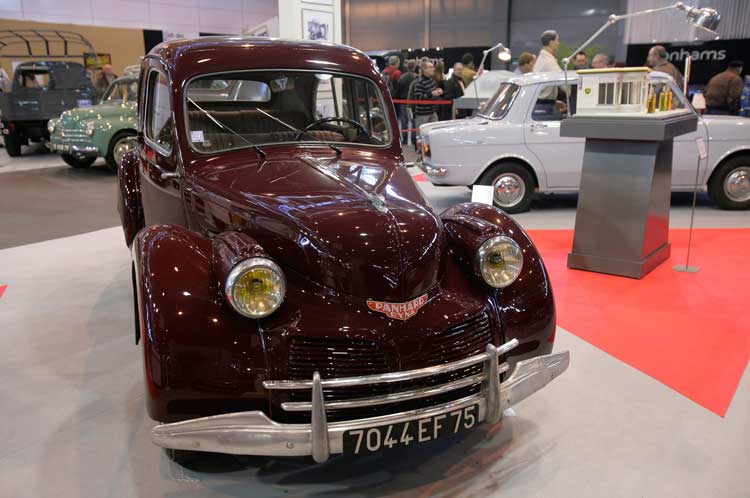Panhard
Brian Sewell looks back half-a century at a design that was ahead of its time. If only they'd made them properly

At the end of World War Two the French Motor industry was in almost terminal desolation. A commentator at the 1948 Paris Motor Show remarked that, though Hotchkiss, Talbot-Logo and Delahaye were represented with grands routieres, all these were confronting oblivion, and that such future as there was lay with the economy cars of Renault, Simca and Panhard. Of these, only the Panhard was extraordinary, not for the saloon body that could just accommodate four Lilliputian passengers, but for its engine.
At the end of World War Two the French Motor industry was in almost terminal desolation. A commentator at the 1948 Paris Motor Show remarked that, though Hotchkiss, Talbot-Logo and Delahaye were represented with grands routieres, all these were confronting oblivion, and that such future as there was lay with the economy cars of Renault, Simca and Panhard. Of these, only the Panhard was extraordinary, not for the saloon body that could just accommodate four Lilliputian passengers, but for its engine.
Imagine half a VW Beetle engine, air-cooled, with two cylinders horizontally opposed, of only 610cc, producing at 4,000rpm 24bhp to the VW's 25. Imagine it mounted well to the fore, driving the front wheels. And now imagine the engine bored out to 850cc, with a power output of 42bhp at 5,000rpm, fitted in the aerodynamic nose of a saloon capable of seating six adults, three abreast front and rear, their luggage in a capacious boot -- for this is what the little Dyna became in 1954.
The Dyna-Panhard 54 was great, inspired, memorable, but not a pretty creature. Its headlamp eyes were far too close and the orifice through which the engine breathed resembled a toothless mouth in which lolled a prominent tongue.
There was, however, no denying the aerodynamic superiority of a design that seemed so wholly incompatible with so inconspicuous an engine, almost invisible when the vast bonnet opened, and the Panhard could claim the lowest drag coefficient of all mass production cars half-a-century ago.
It looked acceptable in black with a white roof, but in the more common liveries of pastel gray, pastel blue, pastel green and, worst of all, pastel beige, all in paint of the poorest quality, it was shabby. Nor was its appearance helped by bumpers of unpainted and unpolishable Duralinox, the patented lightweight alloy of which it was constructed.
The interior, too, was abysmal, each seat a bench of slippery, beige plastic that allowed even the three fat women of Antibes to sit abreast, congealing with sweat.
The Autocar that covered the London motor show of 1954 used the word "sensation" of the Panhard and observed that its "spanking performance equalled that of the better 1.5-litre cars". Its nearest English equivalent was the 2,088cc Standard Vanguard in that both cars attempted to be aerodynamic (the Vanguard unsuccessfully), seated six (the Panhard more comfortably), and aimed at a cruising speed of 70mph.
The Standard, however, though more than a foot shorter than the Panhard, weighed twice as much, and the 68bhp of its 2-litre lump could not outpace the larger car's diminutive free-revving engine.
As time passed the frumpy body was neatened in detail so that its profile became almost svelte, and by 1962 Panhard's engineers had boosted the engine to 60bhp at 5,750rpm and called it Tigre; this was fitted to one of the prettiest small coupes ever built, as well as the saloon that could reach 90mph.
By 1964, alas, the latter was too familiar; it was still a brilliant car, still "The car that makes sense" -- its advertising slogan -- in terms of pace, space and economy, but the lightweight body on a lightweight frame was, in passenger protection, no match for the still-futuristic Citroën Deesse, and the junk yards of France were littered with Panhard carcasses.
The oldest of French manufacturers, always innovative engineers rather than profit-making businessmen, Panhard had no reserves with which to work on a replacement; in 1965 it fell into the maw of Citroën who killed it a year later.
Just think of it -- with 60bhp from two cylinders horizontally opposed, their combined capacity only 848cc, the Panhard's astonishing engine was in Porsche 911 territory; if only Citroën had thought of making a flat-six of it for their DS -- then how much greater a great car that would have been.
Join our commenting forum
Join thought-provoking conversations, follow other Independent readers and see their replies
Comments
Bookmark popover
Removed from bookmarks